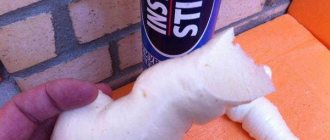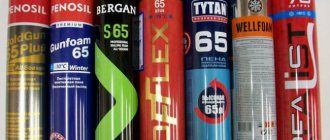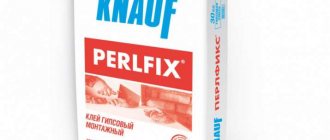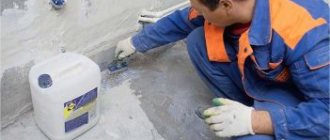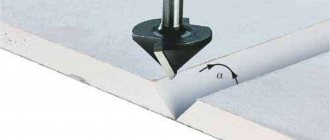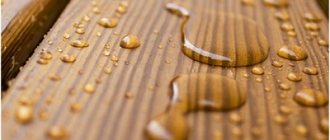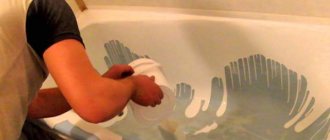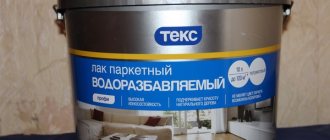Features of polyurethane foam
The material has a polyurethane base .
Interacting with moisture present in the air and on the treated surface, it increases in volume. Soon after application, polymerization of the composition begins; after some time (usually from 15 minutes to an hour), it hardens. The material is lightweight, so the load-bearing structures are not loaded; the texture has a large number of air bubbles. Not any foam is suitable for waterproofing , but only its waterproof varieties. Most polyurethane compounds are hygroscopic due to the abundance of bubbles. In a bathroom, damp basement and similar rooms, such sealant will quickly become unusable.
Waterproof polyurethane foam is distinguished by its texture: only about 10% of the bubbles in it open. Thanks to this, the material almost does not absorb water and can be used for waterproofing work in damp rooms.
Polyurethane compounds are used for a wide range of works :
- sealing various kinds of cracks and cracks (between the bathtub and the wall, in the bathroom, boat, etc.);
- insulation of premises;
- sound insulation (for example, doors);
- filling voids around heating and water pipes;
- sealing gaps in door and window frames;
- roof sealing and insulation;
- as a base on which wall panels are planted.
Pros and cons of polyurethane foam
Can be used for many different tasks
Good thermal and sound insulation qualities
Non-conductivity of electric current
Light weight
Can be used with most building materials - wood, metal, stone, concrete and a number of others
Adhesive properties
Easy to install
Long service life (for cylinders that have not yet been used)
The need to protect skin, eyes and breathing openings during installation work
Destruction due to direct sunlight
Valera
The voice of the construction guru
Ask a Question
In terms of properties, waterproof foam has some differences from regular foam. It is more prone to changes in size due to temperature fluctuations, which must be taken into account during installation. When some of these foams dry, they form a film on the surface that provides resistance to moisture. It cannot be damaged, so cutting off excess during installation is not practiced.
Polyurethane foam and its types
No type of construction or renovation work can be imagined without the use of this material. Using this tool, you can mount various elements of the room. Let's first look at the applications of this product.
Areas of use
There are different areas of use:
- The material is used for sound insulation. Polyurethane foam can prevent the spread of noise from air conditioning, heating appliances, and water pipes. To do this, all holes in the walls and pipe joints are filled with this building product. That is, for sealing.
- Carrying out thermal insulation and waterproofing. Thanks to this product, you can seal defects in the roof. You can insulate rooms that are cold. You can fill all the voids that are around pipes, doors and windows. The main property of this product is sealing.
- Carrying out gluing. Thanks to it, it is possible to connect different components that are made of a variety of materials.
Using polyurethane foam
Let's consider the most necessary recommendations:
- First you need to read the instructions provided by the sealant manufacturer.
- Before starting work, the can must be shaken.
- To ensure excellent adhesion (adhesion to the surface), the coating must be moistened before applying the substance.
- If the procedure will take place at low temperatures, it is necessary to heat the can. This can be done in warm water. The polyurethane foam should heat up to five degrees Celsius.
- If you need to fill holes that are vertical, then filling occurs from the bottom up.
- The foam becomes hard only eight hours after application. After you have applied it, cut off the excess material after 60 minutes.
- Ultraviolet rays have a detrimental effect on this product, so it is necessary to coat it with a primer, paint or plaster.
Be sure to follow these tips.
Properties of polyurethane foam
Now let's look at the technical characteristics and properties of the building material:
- The application process can be carried out using a gun with an applicator. Thanks to this construction tool, the procedure will go much faster.
- The product allows you to fill voids between structural components, thereby increasing their waterproofing characteristics and strength. Relatively moisture resistant, not afraid of moisture.
- Foam in aerosols acquires its relevance at low temperatures.
- The material has a high level of resistance to mechanical damage.
- The product sets and is fixed in a short period of time.
Thanks to these properties, construction foam can be used in different places:
- It is used on boats and rafts to seal various cracks.
- It can be used to seal cracks and holes in the roof.
- Fills voids in window and door frames.
- The voids that are located around heating and water pipes are filled.
- Masonry made of stone or concrete acquires waterproofing properties when cracks are sealed.
- Sand dams can also be protected from water damage.
When foam for waterproofing interacts with water, it begins to swell and increase in volume. Afterwards it hardens within 24 hours.
Waterproof polyurethane foam for the bathroom does its job perfectly. During the installation of the bathtub, cracks appear between the walls, which can be repaired using polyurethane foam. How to do it?
When insulating a bathroom, foam is used as follows:
- Buy a spray can that is intended for household use.
- It should be kept in a room at room temperature for some time, after which it should be shaken.
- The foam should be squeezed out carefully and carefully into the cracks.
- When the product has time to dry, it is necessary to cut off the excess parts. This can be done using a knife.
- In order to improve the waterproofing characteristics, it is necessary to apply grout.
Might be interesting
Waterproofing
How to choose the right floor waterproofing for screed?
Waterproofing
Foundation waterproofing: optimal choice of technology
Waterproofing
Clean water is the key to health, waterproofing concrete…
Waterproofing
Instructions for waterproofing a swimming pool
Polyurethane foam for waterproofing work can be purchased in cylinders. Its type is a liquid propellant or prepolymer. As soon as the product leaves the container, the hardening reaction begins, after which rigid polyurethane foam is formed.
Since this building product has a low level of electrical conductivity and moisture resistance, it is most often used for sound insulation. Foam can be used both for external and internal work. The foam is waterproof.
Types of polyurethane foam
In total, you can find two types of this substance on the construction market:
- professional product;
- household product.
Professional waterproofing foam is applied only using a specially designed gun with an applicator.
The household substance is applied using a spray can. When you use construction material, do not throw away a can that is already half empty. You need to insert the screw into the plastic tube. After some time, if you need, you can use the same foam. If this is not done, the product will simply harden and be unusable.
Features of the household product:
- Has a large expansion during hardening.
- The can is not always of high quality because most of the product is not used.
- The output canister has a small volume.
Features of a professional product:
- The canister at the outlet has a large volume.
- The structure of the material is dense.
- Expansion: 10 to 40 percent.
Any type of product must be applied carefully and evenly. The applied layer must be thin. Thanks to this, you can save substance, and then you will not need to eliminate unnecessary parts.
What to consider when choosing
It is important to consider the expansion rate of the foam.
The most important thing for waterproofing is the product's ability to act as a barrier to water . If the material allows moisture to pass through, it is not suitable for these purposes. You should also pay attention to the following characteristics:
- the severity of the primary and secondary expansion of the composition (a significant parameter for accurate filling of cavities);
- volume of material output;
- fire resistance;
- temperature values at which repair and operation of this foam are possible.
Speed of drying is also important. It is recommended to study the manufacturer's installation instructions, in particular how to remove excess material.
How to use polyurethane foam correctly
Before starting work, the surface must be cleaned of dirt .
This can be done with a damp soft cloth: the foam sticks to a wet surface better than to a dry one. Before applying the sealant, you need to protect your skin from possible contact by wearing closed clothing. A respirator, safety glasses and gloves are also prepared.
The cleaned surface must be degreased to improve adhesion. Then the surface is moistened.
If work is carried out in a cold room, the foam should be slightly heated (the recommended temperature is indicated on the packaging). This can be done by placing the balloon in warm (20-25 degrees) water. Another option is to keep it in a heated room for several hours.
Under no circumstances should you use a water bath or elevated temperatures in general, otherwise the bottle may explode.
Before starting work, the container must be shaken. Then the cap is removed from it and the tube is installed (or the bottle is placed in the gun, depending on the type of composition).
When working, the cylinder is held upside down . This is important because otherwise the gaseous part of the contents will come out first, and the liquid foam will remain in the bottle. The substance must be directed at right angles to the surface to be treated.
Valera
The voice of the construction guru
Ask a Question
If you use household foam, you don’t need to squeeze out too much of it: just fill the gap 30%. This is due to the strong increase in volume of the sealant shortly after application. Professional products do not have this property, so they are immediately squeezed out as much as needed.
If splashes have stained adjacent surfaces, they should not be removed with water or a wet cloth . Trying to do this will only speed up the expansion of the foam and its setting. For the procedure, acetone or special solvents are used . Excess is cut off 8 hours after application.
Some sealants cannot be cut. In this case, it is important to especially carefully monitor the amount of foam squeezed out.
The frozen surface can be painted to protect it from ultraviolet radiation.
Sealing technology
To properly seal defects, it is necessary to carefully prepare the surface. You need to clean it of dirt, dust, and treat it with a universal degreaser or acetone. After this, the foam container should be shaken well to mix all the components. You do not need to fill the gap or hole completely - about 2/3 of the total volume. After application, the foam increases several times, so it is necessary to leave free space for its expansion. You can cut off the excess only after it has completely hardened. Drying time is indicated on the can.
Manufacturers rating
Since sealing joints in rooms with high humidity is one of the most popular procedures, many manufacturers of professional polyurethane foams produce their products in two versions - standard and waterproof. Among them there are products for different temperature conditions. Before purchasing, you should read the rating:
- A wide range of waterproof polyurethane foams is produced by the Polish company Tytan . Among them there are summer and winter, professional and household options. They are well suited for heat and sound insulation work. Some products contain antibacterial components that prevent the contamination of surfaces by mold and mildew.
- Hauser company produces all-season foams that can withstand extreme frosts (down to -50 degrees). However, you cannot work with them in such conditions: during installation and for 24 hours after that, the air temperature should not fall below -10 degrees. After hardening, the foam can be trimmed, plastered, or painted. It sets quickly - within 5-10 minutes.
- Makroflex is an Estonian brand that produces a wide range of waterproof foams in cans of different sizes: with a tube and for a gun, for winter and summer. Before opening, the bottle can be stored for one year from the date of manufacture. Professional compositions are resistant to precipitation. They can be painted and plastered without primer.
- The Belgian company Soudal produces waterproof household foams - polyurethane and prepolymer. The latter are intended for winter use and have excellent performance properties: vapor permeability, resistance to fungus and mold, extreme frosts and even ultraviolet radiation. The line includes options that are not subject to fire. Installation of this product is carried out at a temperature not lower than -10 degrees.
Sealant cannot be applied to some types of materials. These include silicone, polyethylene, Teflon products, as well as items coated with oil or grease. Foam does not stick to these materials in principle.


